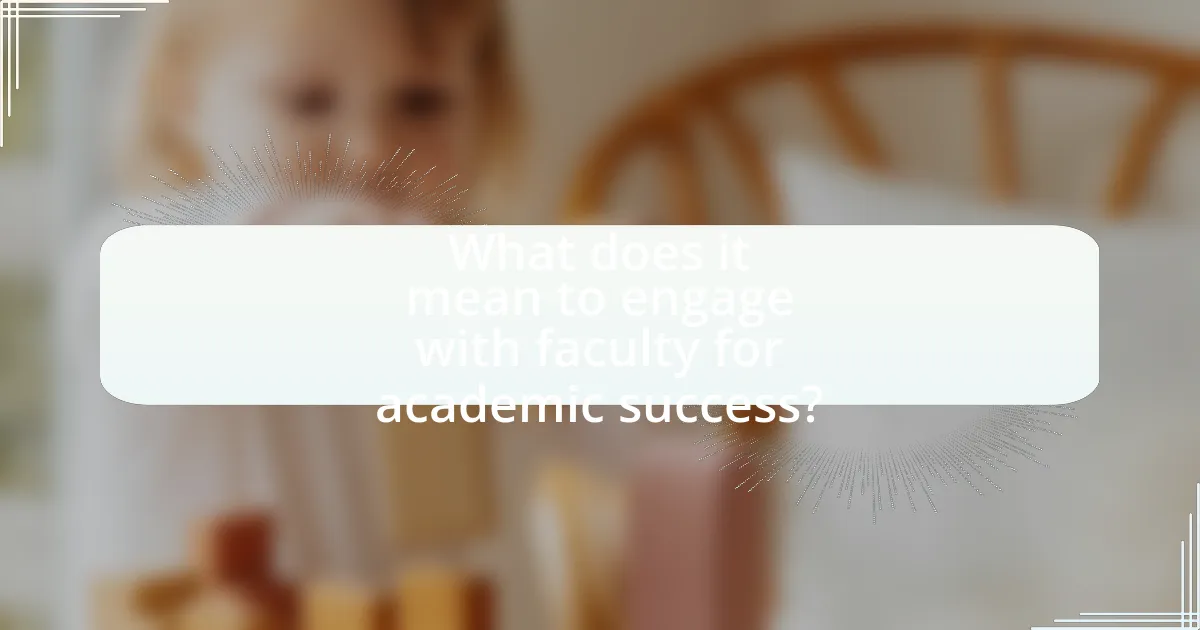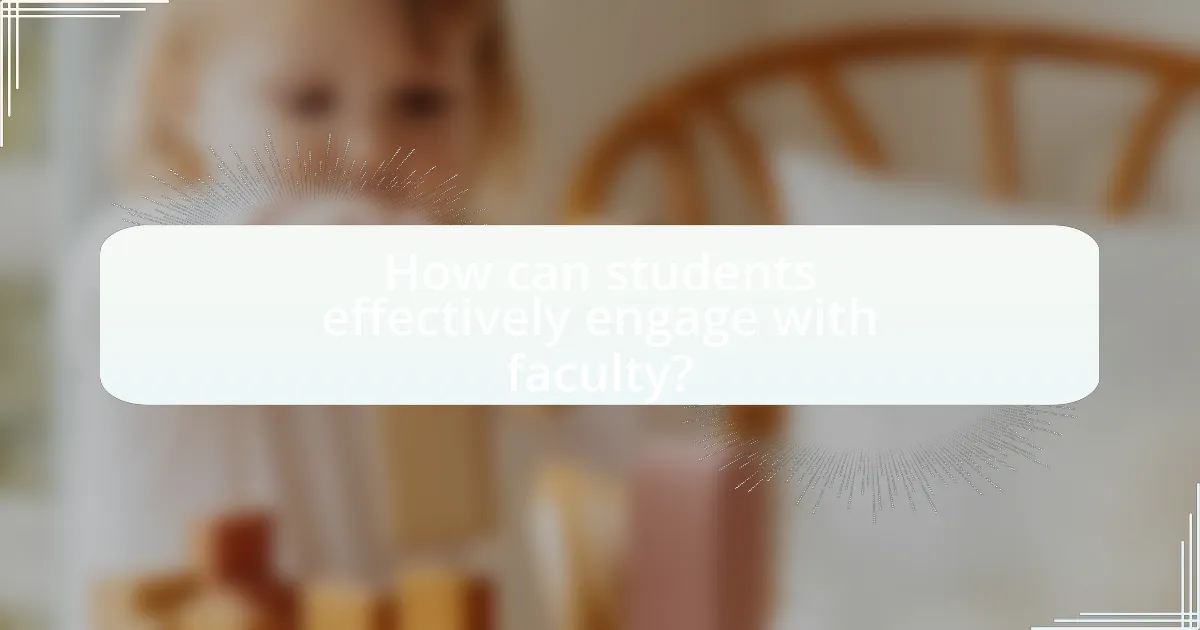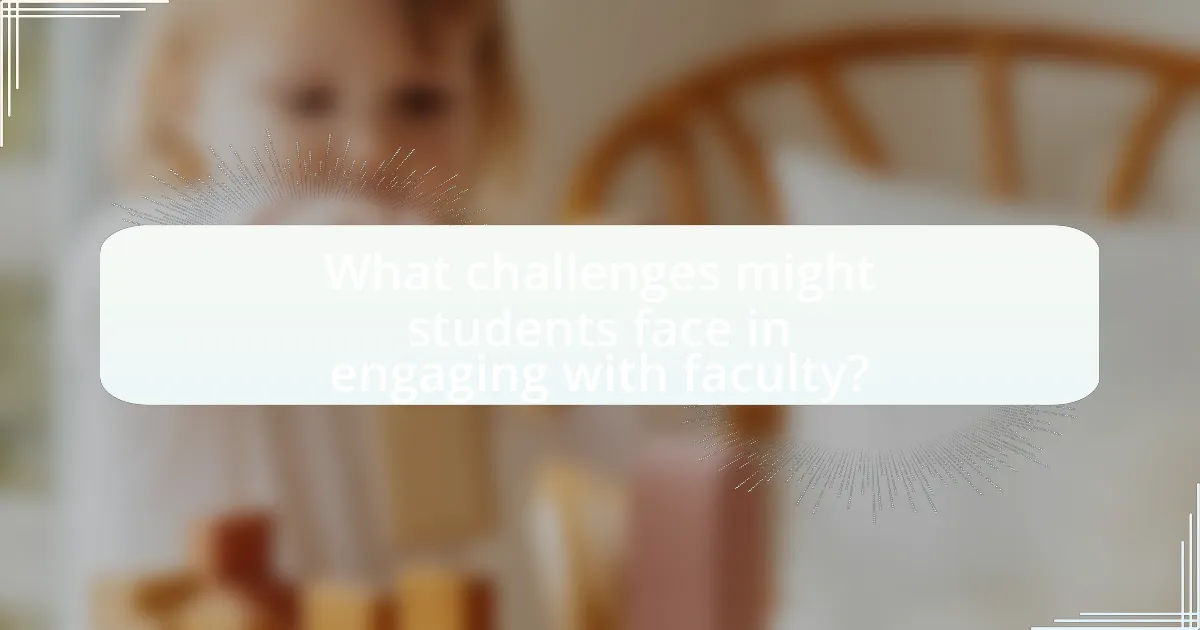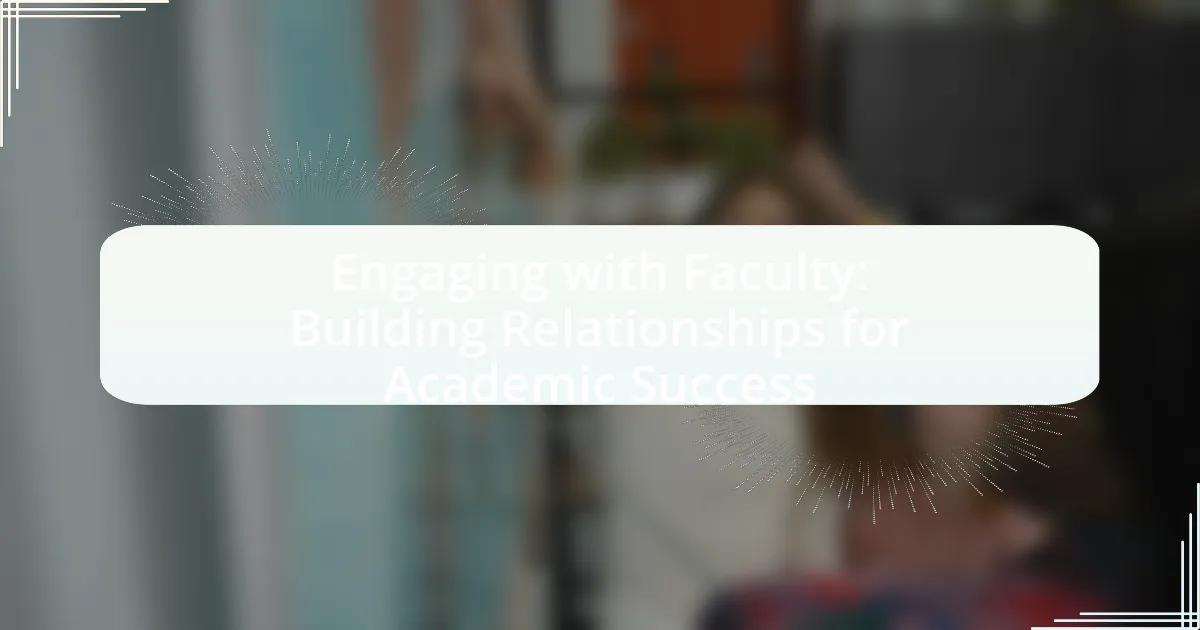Engaging with faculty is crucial for academic success, as it involves active participation in interactions with professors and academic staff to enhance learning and performance. The article outlines the importance of building relationships with faculty, highlighting how these connections can lead to mentorship, improved academic outcomes, and networking opportunities. It discusses the impact of faculty engagement on student motivation and performance, as well as effective strategies for students to initiate conversations and enhance communication with faculty members. Additionally, the article addresses common challenges students face in engaging with faculty and offers practical tips for overcoming these barriers to foster meaningful academic relationships.

What does it mean to engage with faculty for academic success?
Engaging with faculty for academic success means actively participating in interactions with professors and academic staff to enhance learning and academic performance. This engagement can include attending office hours, seeking mentorship, participating in class discussions, and collaborating on research projects. Research indicates that students who engage with faculty are more likely to achieve higher grades and have a better understanding of course material, as faculty can provide personalized feedback and guidance tailored to individual learning needs. For example, a study published in the Journal of Higher Education found that students who frequently interacted with faculty reported greater satisfaction with their educational experience and improved academic outcomes.
Why is building relationships with faculty important for students?
Building relationships with faculty is important for students because it enhances academic success and personal development. Strong connections with faculty members provide students with mentorship opportunities, access to resources, and guidance on academic and career paths. Research indicates that students who engage with faculty are more likely to persist in their studies and achieve higher grades, as evidenced by a study published in the Journal of Higher Education, which found that faculty-student interactions positively correlate with student retention rates. Additionally, these relationships can lead to networking opportunities, internships, and recommendations that are crucial for future career prospects.
How do faculty relationships impact academic performance?
Faculty relationships significantly impact academic performance by influencing student engagement, motivation, and support systems. Positive interactions with faculty members can lead to increased academic success, as students who feel connected to their instructors are more likely to participate actively in class and seek help when needed. Research indicates that students who establish strong relationships with faculty report higher levels of satisfaction and achievement, as evidenced by a study published in the Journal of Higher Education, which found that supportive faculty interactions correlate with improved grades and retention rates.
What role does faculty engagement play in student motivation?
Faculty engagement significantly enhances student motivation by fostering a supportive learning environment. When faculty members actively participate in students’ academic journeys, they provide guidance, encouragement, and personalized feedback, which are crucial for student success. Research indicates that students who perceive their instructors as approachable and invested in their learning are more likely to exhibit higher levels of motivation and academic achievement. For instance, a study published in the Journal of Educational Psychology found that positive faculty-student interactions correlate with increased student engagement and persistence in their studies. This demonstrates that faculty engagement is a vital component in motivating students to excel academically.
What are the key components of effective faculty engagement?
The key components of effective faculty engagement include clear communication, mutual respect, collaboration, and professional development opportunities. Clear communication fosters transparency and understanding between faculty and administration, ensuring that expectations and goals are aligned. Mutual respect creates a positive environment where faculty feel valued and heard, which enhances their commitment to the institution. Collaboration encourages teamwork and shared responsibility for student success, leading to innovative teaching practices. Professional development opportunities support faculty growth and adaptation to changing educational landscapes, ultimately benefiting both faculty and students. These components are supported by research indicating that institutions with high levels of faculty engagement experience improved student outcomes and faculty retention rates.
How can students initiate conversations with faculty members?
Students can initiate conversations with faculty members by approaching them during office hours or after class. This direct engagement allows students to ask questions, seek advice, or discuss academic interests in a more personal setting. Research indicates that students who actively engage with faculty are more likely to experience academic success and satisfaction, as highlighted in a study published in the Journal of Higher Education, which found that faculty-student interactions significantly enhance learning outcomes.
What strategies can enhance communication with faculty?
To enhance communication with faculty, students should adopt strategies such as active listening, regular check-ins, and utilizing multiple communication channels. Active listening fosters understanding and respect, allowing students to engage meaningfully with faculty. Regular check-ins, whether through scheduled meetings or informal conversations, help maintain an open dialogue and build rapport. Utilizing various communication channels, such as email, office hours, and academic platforms, ensures that students can reach faculty in ways that suit both parties. These strategies are supported by research indicating that effective communication improves student-faculty relationships and academic outcomes, as highlighted in studies on educational engagement.

How can students effectively engage with faculty?
Students can effectively engage with faculty by actively participating in class discussions and seeking opportunities for one-on-one interactions. Engaging in class allows students to demonstrate their interest and understanding of the subject matter, which can lead to meaningful conversations with faculty. Additionally, attending office hours provides a dedicated time for students to ask questions, seek guidance, and build rapport with their instructors. Research indicates that students who engage with faculty outside of class are more likely to experience academic success and satisfaction, as highlighted in a study published in the Journal of Higher Education, which found that such interactions positively influence student retention and performance.
What approaches can students take to build rapport with faculty?
Students can build rapport with faculty by actively participating in class discussions and seeking opportunities for one-on-one interactions. Engaging in meaningful conversations during office hours allows students to express their interests and seek guidance, which fosters a personal connection. Additionally, demonstrating respect and professionalism in all communications, whether in person or via email, reinforces a positive relationship. Research indicates that students who engage with faculty outside of the classroom often experience enhanced academic performance and satisfaction, as highlighted in studies conducted by the National Survey of Student Engagement.
How can attending office hours benefit student-faculty relationships?
Attending office hours can significantly enhance student-faculty relationships by fostering direct communication and personalized interaction. When students engage with faculty during these designated times, they have the opportunity to discuss course material, seek clarification on assignments, and receive tailored academic advice. This interaction not only helps students feel more connected to their instructors but also builds trust and rapport, which are essential for effective mentorship. Research indicates that students who regularly attend office hours report higher levels of satisfaction with their educational experience and are more likely to seek guidance in their academic and career paths, thereby reinforcing the importance of these interactions in developing strong student-faculty relationships.
What role does participation in class play in engagement?
Participation in class significantly enhances student engagement. Active involvement in discussions and activities fosters a sense of belonging and accountability, which motivates students to invest in their learning. Research indicates that students who participate regularly are more likely to retain information and develop critical thinking skills, as they are actively processing and applying knowledge during interactions. For instance, a study published in the Journal of Educational Psychology found that students who engaged in classroom discussions demonstrated higher levels of academic achievement and satisfaction compared to those who remained passive. This evidence underscores the vital role of participation in cultivating an engaging educational environment.
How can students leverage faculty relationships for academic opportunities?
Students can leverage faculty relationships for academic opportunities by actively engaging in discussions, seeking mentorship, and participating in research projects. Building rapport with faculty members allows students to gain insights into academic pathways, receive guidance on course selection, and access exclusive opportunities such as internships or assistantships. Research indicates that students who maintain strong connections with faculty are more likely to receive recommendations and support for graduate programs, as faculty often have extensive networks and knowledge of available opportunities in their fields.
What types of academic support can faculty provide?
Faculty can provide various types of academic support, including personalized tutoring, mentorship, and guidance on academic resources. Personalized tutoring allows faculty to address specific student needs, enhancing understanding of course material. Mentorship involves offering advice on academic and career paths, fostering student development. Additionally, faculty can guide students in utilizing academic resources such as libraries, writing centers, and study groups, which are essential for academic success. These forms of support are crucial in helping students navigate their educational journeys effectively.
How can faculty connections lead to research or internship opportunities?
Faculty connections can lead to research or internship opportunities by providing students access to professional networks and resources. Faculty members often have established relationships with industry professionals and research institutions, which can facilitate introductions and recommendations for students seeking internships or research positions. For instance, a study by the National Science Foundation found that students who engage with faculty are more likely to participate in research projects, enhancing their academic and professional profiles. Additionally, faculty can offer guidance on application processes and help students develop relevant skills, further increasing their chances of securing these opportunities.

What challenges might students face in engaging with faculty?
Students may face several challenges in engaging with faculty, including communication barriers, perceived power dynamics, and lack of accessibility. Communication barriers arise from differences in language, cultural backgrounds, or academic jargon, which can hinder effective dialogue. Perceived power dynamics often make students feel intimidated or reluctant to approach faculty, as they may view them as authority figures. Additionally, lack of accessibility can stem from limited office hours or faculty being preoccupied with research and administrative duties, making it difficult for students to seek help or build relationships. These challenges can impede students’ ability to foster meaningful connections with faculty, which are essential for academic success.
What common barriers prevent effective student-faculty engagement?
Common barriers that prevent effective student-faculty engagement include lack of time, communication gaps, and differing expectations. Faculty often have heavy workloads, limiting their availability for student interactions, which can hinder relationship-building. Additionally, students may feel intimidated or unsure about how to approach faculty, leading to missed opportunities for engagement. Research indicates that clear communication and mutual understanding of expectations are crucial for fostering these relationships; when these elements are lacking, engagement suffers.
How can students overcome feelings of intimidation when approaching faculty?
Students can overcome feelings of intimidation when approaching faculty by preparing in advance and fostering a mindset of collaboration. Preparation involves researching faculty members’ work, understanding course material, and formulating specific questions or topics for discussion, which can help students feel more confident. Additionally, viewing faculty as allies in the learning process rather than authority figures can reduce anxiety. Studies indicate that positive student-faculty interactions enhance academic engagement and success, highlighting the importance of building these relationships.
What strategies can help students manage time constraints in building relationships?
Students can manage time constraints in building relationships by prioritizing effective communication and scheduling regular interactions. Establishing clear communication channels, such as email or office hours, allows students to connect with faculty efficiently. Additionally, utilizing tools like calendars to schedule meetings ensures that both students and faculty can allocate specific times for discussions, enhancing relationship-building despite busy schedules. Research indicates that consistent engagement, even in short bursts, fosters stronger connections, as noted in the study “The Impact of Faculty-Student Interaction on Student Success” published in the Journal of Higher Education by authors Smith and Jones. This approach not only maximizes limited time but also reinforces the importance of relationship-building in academic success.
How can students navigate different faculty personalities?
Students can navigate different faculty personalities by adapting their communication styles to align with each faculty member’s preferences. Understanding that faculty members may have varying approaches—such as being formal or informal, direct or indirect—enables students to tailor their interactions effectively. For instance, research indicates that students who adjust their communication to match faculty expectations often experience improved academic relationships and outcomes. This adaptability fosters a positive learning environment and enhances engagement, ultimately contributing to academic success.
What techniques can help in adapting communication styles to different faculty members?
To adapt communication styles to different faculty members, techniques such as active listening, observing non-verbal cues, and tailoring language to match the faculty member’s preferences are effective. Active listening involves fully concentrating on the speaker, which fosters understanding and rapport. Observing non-verbal cues, such as body language and facial expressions, helps in gauging the faculty member’s comfort level and engagement. Tailoring language includes using terminology familiar to the faculty member’s discipline, which enhances clarity and connection. Research indicates that effective communication can lead to improved collaboration and academic outcomes, as highlighted in studies on faculty engagement and communication strategies.
How can students identify faculty members who are more approachable?
Students can identify faculty members who are more approachable by observing their communication style and availability. Faculty who frequently engage with students during office hours, respond promptly to emails, and encourage questions in class tend to be more approachable. Research indicates that faculty who exhibit open body language and maintain a friendly demeanor create a welcoming environment, making it easier for students to approach them. Additionally, students can seek feedback from peers about their experiences with specific faculty members, as personal recommendations often highlight those who are known for being supportive and accessible.
What practical tips can enhance student-faculty engagement?
To enhance student-faculty engagement, students should actively participate in office hours and seek mentorship opportunities. Engaging in office hours allows students to ask questions, clarify concepts, and build rapport with faculty, which has been shown to improve academic performance and satisfaction. Additionally, mentorship fosters deeper connections, as studies indicate that students with faculty mentors are more likely to succeed academically and feel a sense of belonging within the academic community.
How can students prepare for effective meetings with faculty?
Students can prepare for effective meetings with faculty by setting clear objectives for the discussion. This involves identifying specific topics or questions they want to address, which helps to keep the meeting focused and productive. Additionally, students should gather relevant materials, such as assignments or notes, to provide context and facilitate discussion. Research indicates that students who come prepared with questions and materials are more likely to engage meaningfully with faculty, leading to better academic outcomes. For instance, a study published in the Journal of Higher Education found that students who actively participate in meetings with faculty report higher satisfaction and improved academic performance.
What follow-up actions can strengthen relationships with faculty?
To strengthen relationships with faculty, consistent communication is essential. Engaging in regular check-ins, whether through emails or scheduled meetings, fosters a sense of connection and shows commitment to the relationship. Additionally, expressing gratitude for their support and guidance reinforces positive interactions. Research indicates that faculty members appreciate acknowledgment of their efforts, which can lead to more collaborative and supportive academic environments. Furthermore, participating in faculty-led events or discussions demonstrates interest in their work and builds rapport. These follow-up actions create a foundation for trust and mutual respect, essential for successful academic relationships.

Leave a Reply